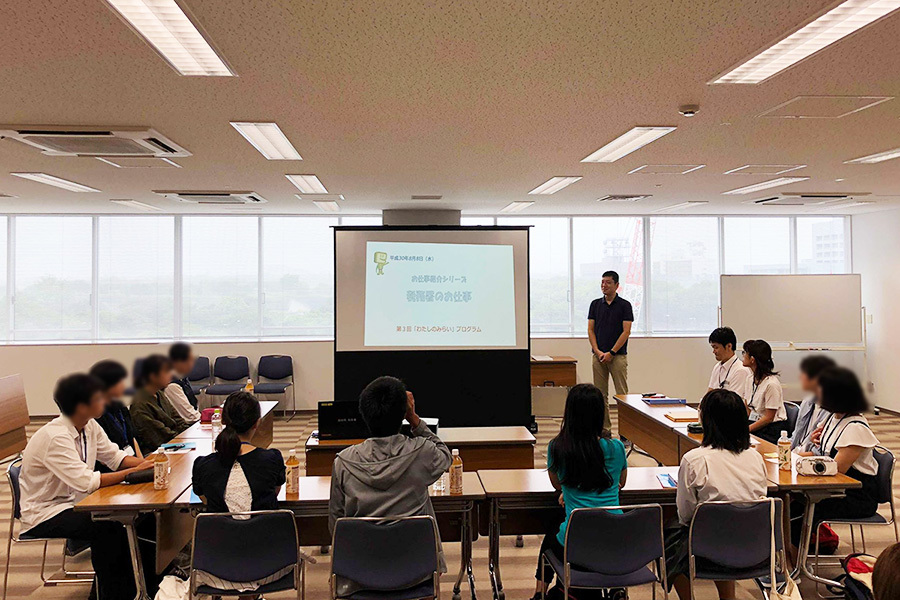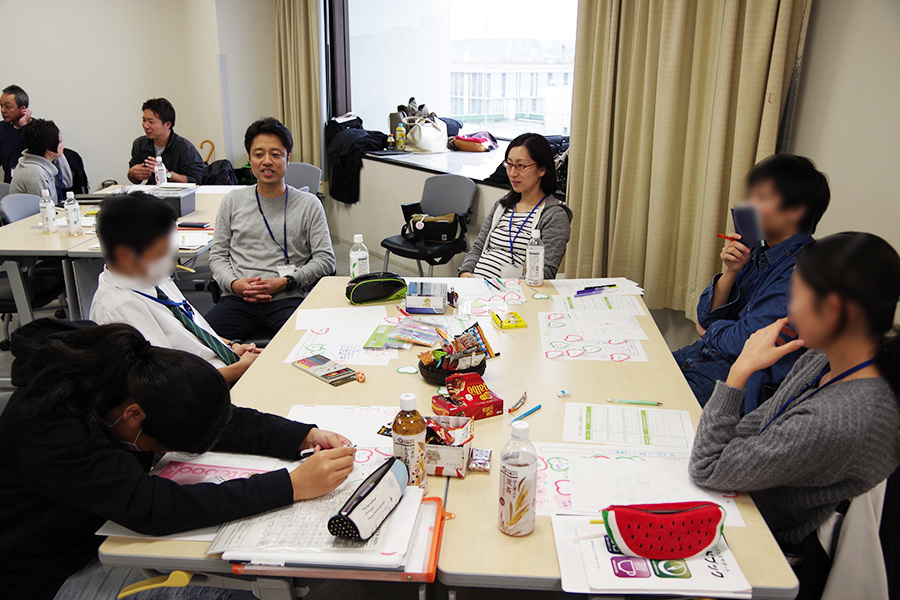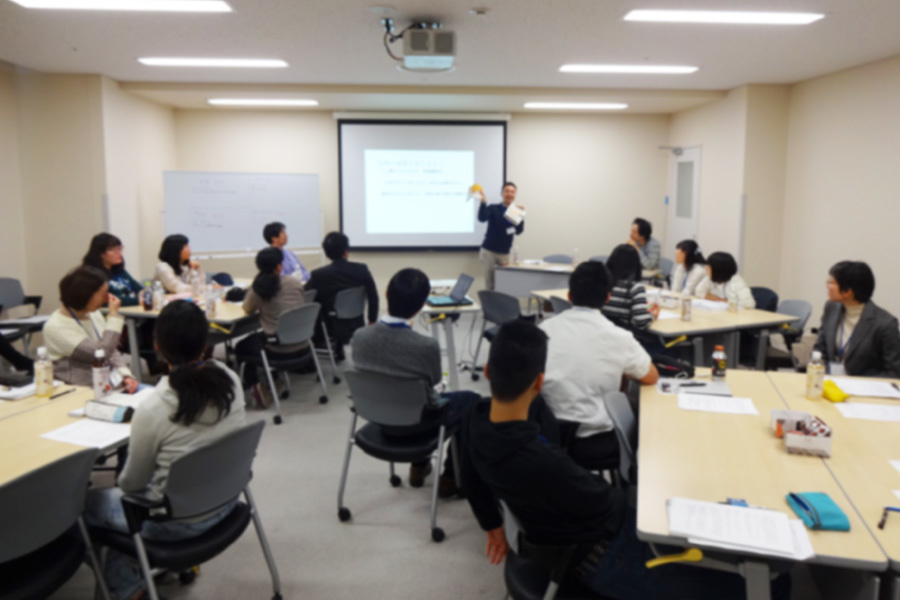NPO Angel Support Centre
The Angel Support Centre is a non-profit organisation (NPO) that provides self-reliance programs for youth living in childcare facilities and foster families. We interviewed Mr. Toshiyuki Takahashi, chairman of the board of directors at the Angel Support Centre, and Mr. Toshikazu Takahashi, who is the father of Mr. Toshiyuki Takahashi and has been continuing his support for the children as honorary school chief of the “Shiseigakuen” childcare facility, established over 100 years ago.

FIT: How did you start the Angel Support Centre?
Takahashi: The Angel Support Centre is a non-profit organisation (NPO) that provides self-reliance programs to children living under social care. In Japan, there are about 40,000 children living in a child care facility or living with a foster family due to various reasons which include abuse at home or being difficult to rear. Each year, about 1,200 young people at the age of eighteen leave the facility or foster family to start living independently in dormitories and apartments. Eighteen is generally the age of a third-year high school student, and it is an age where support and care from parents is still required. Having said this, children living under social care are forced to be more independent than other people at the same age. The major changes in life and the environment stemming from this independence often results in them becoming isolated from society, often leading to other problems. Also, some children have difficulty being optimistic or positive about their future since they tend to label themselves as being from “a facility.” I built the Angel Support Centre because I had a desire to "do something" when I encountered these types of situations every day. We established the centre in 2002 and today operate it with ten plus unpaid employees, who also have paid jobs aside from the work they do with us at the centre.
FIT: Many people may not be familiar with the term "social care"; could you tell us about the situation and the system surrounding these children?
Takahashi: The children’s situation varies depending on the type of facility and the region they live in. For example, children who come to the childcare facility will be admitted to the "safeguards system" that temporarily transfers custody of the child to the facility under civil law. In a sense, this removes parental custody from the parent, but the decision to do this is made by children’s welfare centre based on a variety of circumstances surrounding the particular child. At the childcare facility, children receive both compulsory education and a safe environment.
The Child Abuse Prevention Act became effective in 2000, and if there is a human rights violation, it is possible to intervene forcibly so that children are pulled away from their parents following the judgment of the Child Counselling Centre. In cases where children can make their own decisions, they children can come to the facility without parental consent. Also, if there is a notification that a child is suspected of being abused, it is possible to transfer them to a facility where they can be protected. In cases where parents do not agree to the child entering the facility, the police and child counselling offices can intervene to protect the safety of the child.
Today, the situation surrounding children is becoming more diversified, and problems more complex. What we term as “serious case” victims where family, law enforcement and school problems are compounded, are particularly common in city areas. For example, both parents work in Tokyo while their grandparents take care of their children in regional areas. But since the grandparents were unable to afford to take care of these children, they end up being protected by the facility as a result of coming to Tokyo. A new type of case is where children themselves request to be taken care of at a facility. The primary purpose of the facility is to protect children. This means to not only protect and nurture them, but to also support the rebuilding of relationships between parent and child, and to assist children to again live with their parents by introducing employment opportunities, another important function of the facility. There are some cases that children supported by Angel Support Centre, have resumed living with their parents and siblings by working and acquiring life skills.
FIT: When they turn 18, they still need support from their surroundings. Is it possible for children to remain in the facility once they hit this age?
Takahashi: There is a system called “extended support”, which allow the children to remain in the facility and receive the necessary support even after turning eighteen. The childcare facility is a public facility based on the "Child Welfare Law" with operational costs distributed evenly between the central and local governments. Therefore, even if the central government has a legitimate policy, it may not be able to provide full support depending on the financial situation of the local governments. Even if we want to support the children during their higher education in order to lead them having a better independent life, the children are encouraged to become independent at the age of eighteen due to the facility’s financial constraints. This means we limit the “extended support” to those who have physical disabilities, with most of the children forced to become independent at the age of eighteen. Currently, half of the children living in childcare facilities are teenagers, and they are called "old children". Many of them are anxious about becoming independent in a short few years. Even if there is a system of "extended support", some of them have to leave the facility a couple of years early as there is a long waiting list of children wanting care from us and we only have limited space. Also, the facilities in urban areas are often full.
Considering this, more private-sector support is needed to encourage children to become independent just as we do at the Angel Support Centre. The funding for facilities at social welfare organisations greatly relies on donations from individuals and religious bodies. It is simply unrealistic to cover facility and labour costs within the scope of the budget provided by the central and local governments.
FIT: What made you to start supporting children to become self-reliant?
Takahashi: My family ran a childcare facility and I grew up with children who lived at the facility. I went to the local school with the children at the facility. I had doubts about whether children who had to leave the facility and become self-reliant at the age of eighteen with no support could actually do so.
Years later, my brother at university in the US learned some methods to provide the support needed for children to develop self-reliance which led to the founding of Angel Support. My parents were still running a childcare facility, but my brother and I found a way to support the children through a different platform. At the time, there was little activity to support children becoming independent in Japan, but we thought it was needed for the future so we established the organisation when the NPO Law (Act on Promotion of Specified Non-profit Activities) was enacted.
Initially, existing childcare facilities were sceptical, and this was one of the reasons I established the organisation. At that time, the mainstream idea was "the care of the children is to be completed in the facility, and it is not effective from the child's privacy standpoint that an outside private organisation supports the children." Now, I have followed on from my brother’s work and became the second director of the Angel Support Centre, a role I have had since 2010.
FIT: So it could be said that the system that your brother learned in the United States is being applied for the benefit of children of Japan.
Takahashi: Yes, the US model is a reference, but the situation is very different in the US and Japan. There, the number of childcare facilities is limited as much as possible and foster parents and adoption are mainstream. In the family care system, it is difficult for government or facility staff to openly support children as the children are living with foster or adopted parents. Data from the US shows that the average duration for contracts with foster parents is two years. It means that children are moving from one foster home to another, and it leads to lack of a real “home”. On the other hand, this also means that there are many options available to support the children. Foster care and adoption is very common in the US, and children seem to be thinking independently of their own circumstances, such as “my previous dad owns a farm, and my current dad works at a bank”. In Japan, the mainstream support for children still depends on childcare facilities, and the children do not receive support after they turn eighteen and leave the facility. Here, until the age of eighteen, we take care of the children, but as soon as they turn eighteen, they have to make their own money and live by themselves. Thus, the preparation for life after the facility is crucial. In South Korea, Seoul is incorporating the American self-reliance system as it is. I wish Japan could also establish our own program to encourage children to become independent.
FIT: Is it difficult to adopt foster system in Japan?
Takahashi: By setting up a new social vision, the central government is trying to minimise the number of facilities by shifting their effort to promote foster care, which enables more homely environments to be provided while receiving support from the local community. But, foster parent training is insufficient, and the support system for the foster parents is not yet established.
Also, there are many children who come back to the facility, even after they have been accepted by foster parents. There are a lot of cases where foster parents accept the children without any understanding, creating gap between the reality of being a foster parent and the expectation. The government has been trying to support foster parents through child counselling centres, but no real success has been seen yet. I think this is an important moment. I think the point here is how the system reintegrates children, birth parents and foster families.
FIT: How will the FIT donation be used?
Takahashi: The first pillar of the use of the FIT donation is to create a “space of belonging”. Even after the children leave the facility, I think it is necessary to create a “space” where children who are now independent from the childcare facility or their foster parents, can spend peace of mind with the people and supporters in similar circumstances. After they graduate from high school and leave the facility, they tend to feel alone as they can’t regularly see their friends who they met at the facility due to their busy work schedules. This program for creating a space for the alumni was initiated due to this reality.
Since the children are often not able to rely on their parents, it is very important to learn how to earn money and to receive a university education to become independent. To do so, I think it is important that there are many good mentors in society that understand and support them. This will be the place to meet these mentors and grow. Despite comments such as “I am hesitant to go there because there are adult staff” and “it is awkward to go there since there are some people who are from the same facility”, I hope the children are able to choose their favourite place from many choices made available to them.
Also, I want to use the network of childcare facilities across Japan to support children who come to Tokyo from their prefecture to find employment or go to university.
Often, there are a lot more options in Tokyo compared to where they are from. However, the children who come to Tokyo from their prefecture do not have a network of relationships to rely on, and since there are no role models around them, they easily become isolated. Often, children can’t take that first step towards independence because of these reasons and I am endeavouring to reduce the number of children who experience this. I want to create a space where children can always visit when they seek help or they feel alone.
The second pillar of the use of the FIT donation is the “instructor training program”. This idea was raised by childcare facility alumni attending our self-reliance program for high school students who told us “I don’t want people to think I am here because I am from a facility”. There are so many motivated alumni who come to the event with a strong desire to make an impact on society. The donations from FIT will allow us to implement training programs for these motivated high school students and facility alumni; program graduates will become certified instructors at the Angel Support Centre. Those instructors will initiate various programs, such as study sessions, barbeques and tea sessions so that participants from various backgrounds will get to know each other and learn from each other. We aim to create a new cycle in which children in social care grow and become instructors (also becoming good mentors for the younger generation) and educate the younger generation to become the next instructors.
FIT: So, hearing stories from alumni who have left the facility and became independent by working and impacting on society will motivate younger generations preparing to leave the facility in few years.
Takahashi: Yes, and I think this is very important. It is much more meaningful than staff like speaking to them as their teachers. It is important to come to a place like this and meet people, and hear their real stories and to learn something from them. This will help the children to think about their long-term future. Real life is a series of difficulties. But, it is important to meet people who have similar backgrounds and to ask them about their life and work. I want them to know there is no need to feel encumbered just because they are from a childcare facility. I also think alumni who are married and have children should have an opportunity to share their experiences such as how they approached their partner or the partner’s parents about their personal history before they got married.
Some of the children living with foster families and have been involved in the activities of Angel Support told us "I met a person who has a similar background for the first time in my life through the program”. In a foster home, unlike living in a childcare facility, there are few opportunities to meet people with similar backgrounds so they may feel being isolated from their surroundings. They tend to think that they are the only ones who live with foster parents. By participating in this program, they will understand that there are other people in a similar situation and there are opportunities to talk about things that they were not able talk about before. This helps them feel relieved every time they participate.
Childcare facilities protect children by trying preventing them from having time outside of the facilities to protect their privacy. Although this is effective when it comes to protecting their privacy, the children tend to feel gaps between their life at the facility and their life after the facility once they turn eighteen. I want them to understand that there are people outside who understand their situation. This will be achieved by hearing stories from people who have been through similar experiences and by building relationships with people in their everyday life. By experiencing these events repeatedly, they will eventually realise there are people outside who understand them as they are.
FIT: How do you interact with children who participate in self-reliance programs?
Takahashi: Virtually all children apply for these programs at their own will because they think "I need these programs for myself”. We hold the programs at eleven different locations nationwide from Aomori to Okinawa. Participants come together from facilities and foster homes. We first evaluate if they have their own desires and whether their actions meet their words. Later, we evaluate what they learn etc. using a check sheet that will later become a tool to encourage independence after they graduate. Once the program is finished, they can go back to the check sheet and self-evaluate. They can even visualise their growth before and after the program using the check sheet. By doing so, they will be able to understand not only what they have or have not achieved through the program but it will also help them to evaluate and recognise themselves even more.
FIT: Do you have a message for our readers?
Takahashi: I want to be a part of a society where we all live without caring whether people are from a “facility” or not. I want all people to understand that there are many types of “family” and that a childcare facility is but one type, albeit a diversified one. There are so many people in the world who have a so-called “successful life” even though their background was growing up in a childcare facility. In Japan, there are only few people who would openly share their background of having grown up in a childcare facility. In the US on the other hand, people don’t hesitate to say where they are from. As such I think some people in Japan still have biased views of social care.
While people who grew up in the facility or lived with a foster family do not want people stepping into their life so much, they often seek equal relationships. Children, who grew up in facilities often suffer from mental scars. They have to heal ad overcome these scars through their own will. This requires confidence in themselves. I hope that by us providing them a “place of belonging”, children will be able to meet with a variety of people which will prompt them to think about their future and who they want to become. I also hope that many people will learn about and relate to the activities of the Angel Support Centre and the challenges we are addressing.



